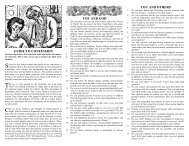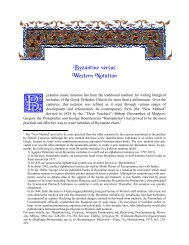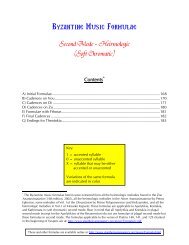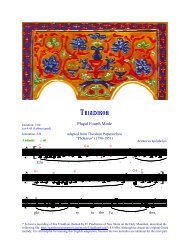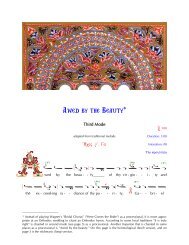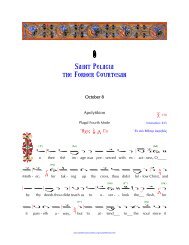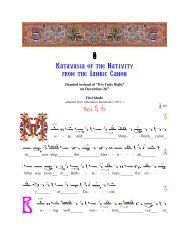Reading Psalmodia (PDF) - St. Anthony's Monastery
Reading Psalmodia (PDF) - St. Anthony's Monastery
Reading Psalmodia (PDF) - St. Anthony's Monastery
Create successful ePaper yourself
Turn your PDF publications into a flip-book with our unique Google optimized e-Paper software.
music - a use that has at least the merit of being highly intuitive. If we use the doubleflatand the double-sharp in this way, then we need only a pair of signs for the flattishand the sharpish.A question may well arise as to exactly what interval a flattish or a very-flat intends.This is a difficult question to answer confidently, since the musical theorists, as hasalready been pointed out, differ as to whether the chant uses twelfths, sixths or quartersof tones. Nonetheless, a general sketch of an answer can be constructed. If we divide theoctave into 72 equal steplets, then• a flattish flattens a note by approximately 1-3 steplets• a sharpish sharpens a note by approximately 1-3 steplets• a flat flattens a note by approximately 4-6 steplets• a sharp sharpens a note by approximately 4-6 steplets• a very-flat flattens a note by approximately 6-9 steplets• a very-sharp sharpens a note by approximately 6-9 stepletsThe exact interval intended by a specific accidental depends on the Tone in which agiven melody is sung. In the Enharmonic modes of Tones III and Varys, for example,the flat lowers a note by an enharmonic semitone of six steplets, whereas in the Diatonicscale on Ni of Tone VIII a flat on Pa flattens it by 5 or 6 steplets, a flat on Vu flattens it by4 or 5. The theory books in common use all offer a more precise definition of the precisedegrees of flatness or sharpness the different accidentals intend, but these preciseprescriptions are frankly implausible, and generally ignore the different intervalstructure of the different Tones.





